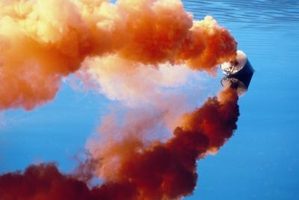 Signal aids are critical to help rescuers pinpoint your boat's exact location in an emergency.
Signal aids are critical to help rescuers pinpoint your boat's exact location in an emergency.
This from the Coast Guard.
A boat on the ocean is a small, hard-to-see target in good conditions, and even with all the technological advances in EPIRBs and communications technology that interface GPS information with the VHF radio, nothing can help rescuers get a visual fix on a boat in distress better than a flare or other visual signaling device. The U.S. Coast Guard requires you to carry the proper visual distress signals on board, and it's important to know how to use the different types in an emergency.
Aerial signals: Aerial signals are used to alert all the boats in the area that you're in trouble. They're fired from a variety of self-contained launchers or specifically designed pistols, and can reach an altitude of 450 to 1,000 feet. The combination of bright light and high altitude makes these flares highly visible from a long way off, but most have a relatively short burn time. The U.S. Coast Guard recommends firing two aerial signals-one immediately after the first has gone out-so that in an emergency, rescuers can confirm the sighting and/or the direction of the signal.
Handheld signals Once you've alerted boats in your area that you're in distress and have given rescuers a general idea of your location with aerial signals (and, often, radio or EPIRB contact as well), a handheld signal emits a bright light that will help your rescuers to zero in on your position. In an emergency, your rescuers have seen your aerial signals, confirmed your position on the radio, and use the light from a handheld to steer directly to you.
Smoke signals: Smoke signals are somewhat similar to handhelds in that they are designed to help pinpoint the location of a vessel in distress; they do so by emitting a thick, colored smoke rather than light. They're obviously of no use in the dark, but in daylight, a big plume of colored smoke is often more visible than the bright but relatively small light emitted by a handheld flare. And most smoke flares will float and work on the water.
All pyrotechnic signaling devices must be stored in a cool, dry place, and most are available with a tough, plastic, waterproof storage case. Make sure you keep the signaling kit in an easily accessible location on your boat. And remember: It's illegal to fire a distress signal in a non-distress situation.